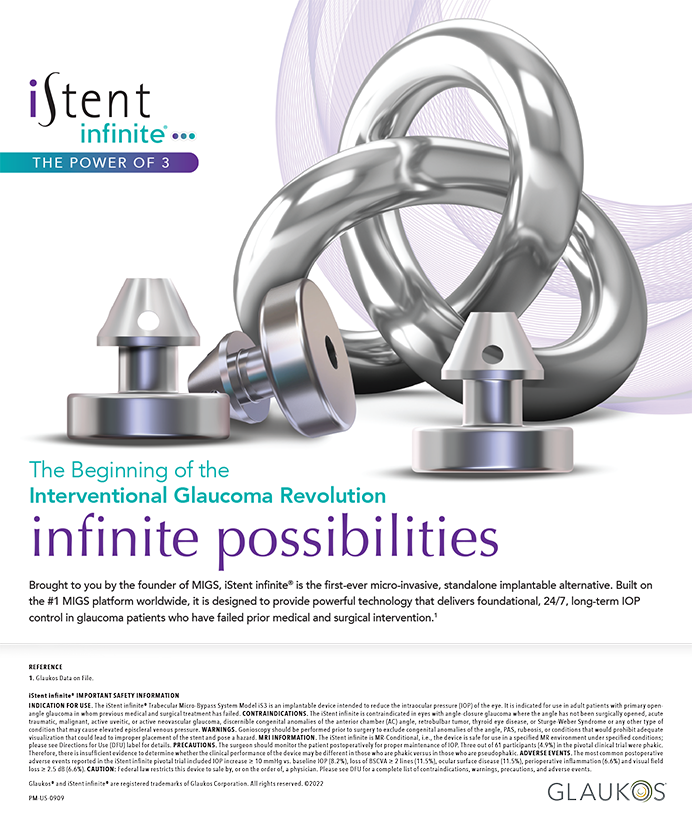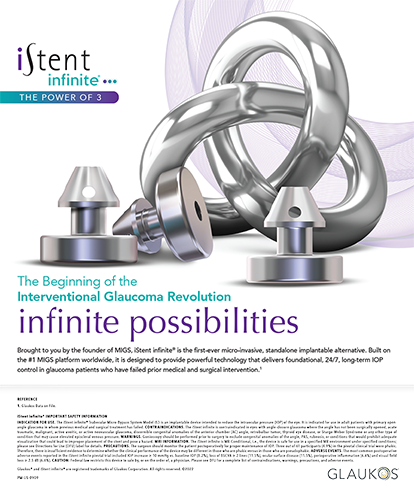We cataract surgeons tend to think of ourselves as either Venturi or peristaltic surgeons, advocating our preferred fluidics style much as a driver might argue the benefits of a manual versus automatic transmission on a car. Although both types of pumps have merit, the choice between them was until recently made at the time of equipment acquisition.
A few years ago, dual-pump systems such as the Stellaris PC Vision Enhancement (Bausch + Lomb) and WhiteStar Signature (Abbott Medical Optics) were developed to satisfy different pumping preferences in a multisurgeon environment. Each could be set up with the Venturi pack for the stick-shift drivers and the peristaltic pack for the automatic drivers.
Even the most passionate sports car driver might find him- or herself wishing for an automatic transmission when rush hour traffic is backed up for miles. Automated dual-clutch transmissions now allow drivers to choose between the speed of a manual and the smoothness of an automatic, and this can be done in the phaco suite as well with the WhiteStar Signature.
Phacoemulsification is composed of two discrete tasks, chopping and segment removal. This article explores the different fluidics required of the phaco pump for each step.
CHOPPING
For chopping, the phaco pump keeps the lens stationary at the tip of the phaco needle by generating a pressure differential between the fluid lines and the anterior chamber when the phaco tip is occluded (Figure 1). This is referred to as “holdability.” For this task, a peristaltic pump is superior, primarily because it has a built-in pressure transducer that tells the surgeon exactly how much vacuum has been generated at the phaco tip. The peristaltic pump can safely generate much higher vacuum levels (≈400-500 mm Hg) compared with Venturi systems (≈150-200 mm Hg with 20-gauge needle tips). In addition, peristaltic pumps can generate this higher vacuum using much lower flow rates (≈20-30 mL/min) than Venturi systems (≈60-70 mL/min). Higher vacuum generates stronger holding power, and lower flow provides a more stable purchase of the lens.
It is no surprise that most cataract surgeons have traditionally preferred a peristaltic phaco machine because it is better for chopping. Segment removal will be difficult regardless of the phaco pump if the chopping that preceded it was executed poorly.
SEGMENT REMOVAL
The surgeon wants nuclear segments to constantly move toward the phaco tip instead of remaining stationary. Nuclear fragments move to the phaco tip because they get caught in the fluid stream heading into it (Figure 2). In fluidics, this is referred to as entrainment, much like a raft would get swept downstream in a rushing river.
During segment removal, a high and uninterrupted flow rate is ideal to use followability to draw nuclear segments out of the capsular bag, allowing the phaco tip to safely stay at the iris plane.
Venturi pumps are better suited to create the optimal fluidic conditions for high followability with a stable chamber during segment removal. First, they can safely generate much higher flow rates (≈60-70 mL/min) than peristaltic pumps (≈30-44 mL/min). Second, Venturi pumps require lower vacuum levels (≈150-200 mm Hg) than peristaltic systems (≈300-450 mm Hg) to generate this flow. Lower vacuum helps prevent line collapse and postocclusion surge, and higher flow rates allow the phaco tip to stay safely central and away from the posterior capsule.
Interestingly, surgeons often think of peristaltic systems as being very safe because of their surge protection features. Automated step-down features are necessary to stop the pump during tip occlusion before the maximum vacuum levels set by the surgeon are exceeded. Quickly stopping the pump at maximum vacuum is much like slamming on the brakes when the traffic light turns red.
Modern Venturi systems feel dramatically more stable than previous generations because of the reduced air volume in the cassette. Older systems were designed with large cassettes so they would not fill up during a case. The Millennium Venturi system (Bausch + Lomb) has a cassette volume of approximately 250 mL, whereas the Stellaris cassette is approximately 300 mL. The Venturi cassette on the latter device is much smaller (≈65 mL) but never fills, because a second peristaltic venting pump senses the fluid level and automatically empties the cassette to maintain a very small but consistent air volume needed to generate vacuum (Figure 3). With a compressible air volume that is five times smaller, the Signature system is more stable than systems without cassette venting pumps.
The Stellaris uses a flow restrictor (cruise control) in the vacuum lines between the phaco handpiece and the Venturi cassette to help prevent postocclusion surge. When occlusion breaks, cruise control prevents a rapid transfer of fluid from the anterior chamber into the vacuum lines. During unoccluded operation, however, a higher cassette vacuum is required to generate a given flow rate compared with systems that do not have a flow restrictor. The higher vacuum in the Stellaris Venturi system improves holdability for chopping, but the unit may not detect occlusion because the platform lacks a pressure transducer in the vacuum lines that is found in peristaltic systems.
Transversal phacoemulsification such as the Ellips FX (Abbott Medical Optics) technology can work synergistically with the excellent fluidic characteristics of the Venturi pump to keep the fragments moving and prevent the “lollipop” tip occlusion that can otherwise reduce the speed and efficiency of segment removal (Figure 4).
PUTTING IT ALL TOGETHER: COMPARING FLUIDICS
The functional differences between peristaltic and Venturi pumps can perhaps be best illustrated by plotting their fluidic properties on a flow-vacuum graph (Figure 5).
There is a linear relationship between flow rate and vacuum for Venturi pumps: doubling the vacuum will double the flow rate as well. The Venturi pump creates a high flow/low vacuum condition in the unoccluded state ideal for segment removal with good followability.
For peristaltic pumps, the flow rate is preset and will remain relatively constant as long as the phaco tip is unoccluded. Nuclear occlusion of the phaco tip increases flow resistance, and vacuum rises accordingly. At some vacuum level below the preset maximum (300 mm Hg in Figure 5), the peristaltic pump will begin to decelerate, and the flow rate will decrease. As the vacuum reaches the preset maximum allowed (450 mm Hg in the illustrative example), the pump stops to prevent further buildup of vacuum. Nuclear material is usually occluding the phaco tip during chopping, so the peristaltic pump will operate in a high-vacuum, low-flow condition ideal for good holdability.
THE RIGHT TOOL FOR EACH TASK
Performing the entire phaco procedure with one type of pump will compromise fluidics. Chopping with a Venturi pump will result in undesirably high flow rates to generate the high vacuum required for holdability. It would be a bit like towing a boat with a Porsche or turbocharging a minivan for a day at the racetrack; the system is being asked to do something at which it does not excel.
The WhiteStar Signature has solved the dilemma of compromised fluidics in single-pump systems by allowing surgeons to switch on the fly between dual pumps with Fusion Fluidics (Abbott Medical Optics). My preferred method of phaco surgery is to begin with peristaltic pumping and chop the nucleus into two to six pieces, depending on its density. In this chopping mode, the flow rate is set relatively low (20-30 mL/min) and vacuum relatively high (≈450 mm Hg; Table). Next, I switch to Venturi to remove the segments at approximately 200 mm Hg for 20-gauge phaco tips and about 300 mm Hg for 21-gauge tips. For the last few segments, I may switch to a slow 150 mm Hg submode, because the remaining segments are already highly mobile, and there is a greater risk of capsular rupture.
CONCLUSION
Using a peristaltic pump for chopping and Venturi for segment removal is the optimal fluidic setup for most cataracts, but it may be easier to use just one pump for some cases. In eyes with very soft lenses, I may rely on Venturi fluidics for the entire case using a phacoaspiration technique. I may depend on peristaltic fluidics in cases of intraoperative floppy iris syndrome and reduce the flow rate to about 20 mL/min to minimize the risk of iris incarceration.
Utilizing the strengths of two pumps—peristaltic for chopping and Venturi for segment removal— offers surgeons the rare opportunity to improve both safety and efficiency in cataract surgery. Now, surgeons can finally get sports car performance but also minivan safety and utility in a single phaco machine.
David B. Yan, MD, is an assistant professor in the Department of Ophthalmology at the University of Toronto and director of the Toronto Ophthalmology Residency Course. He is also director of the Glaucoma Services at Kensington Eye Institute, University of Toronto, and president of the Canadian Society of Cataract and Refractive Surgery. He is a consultant to Abbott Medical Optics. Dr. Yan may be reached at d.yan@sympatico.ca.


